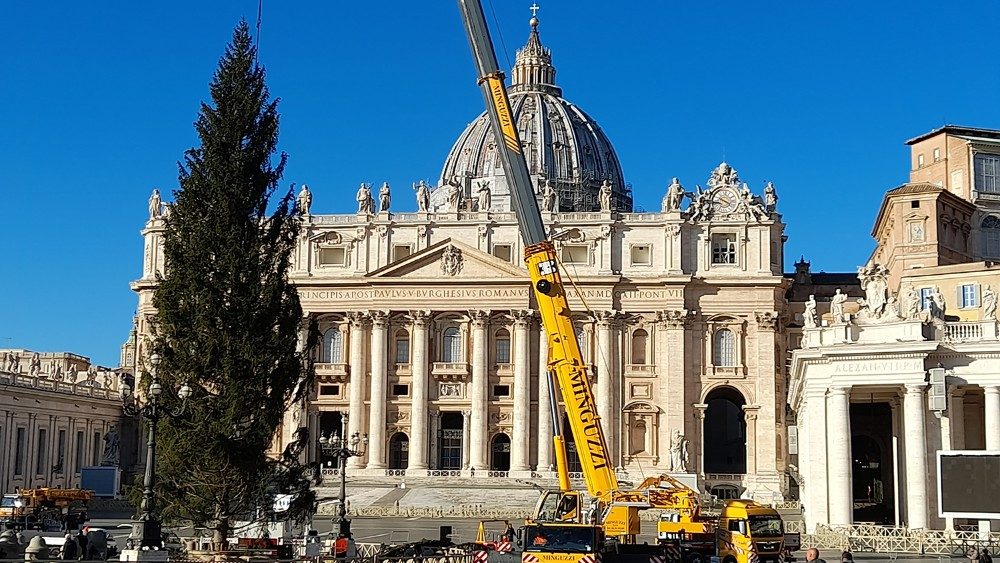The Nativity Scene, which will be set up in Saint Peter’s Square for Christmas 2021, comes from the village of Chopcca, a community in the Department of Huancavelica in Peru. After the Angelus on Sunday, October 24, Pope Francis announced the provenance of the Crib, on greeting the Peruvian community that was celebrating the feast of the Lord of the Miracles. The Nativity Scene will include 30 pieces and has been made by five famous artists of Huancavelica.
The majestic spruce (Picea abies) of close to 28 meters, which will be placed next to the Crib in Saint Peter’s Square, comes from Andalo, in Trentino, in the Dolomite Paganella area. The tree comes from the Sustainable Forest Management of the certified PEFC Trentino Territorial Group. The Trentino Delegation will take care of the related decorations with spherical decorations in wood. As usual, through the Infrastructure and Services Office, the Governorate will take care of the lighting with a low energy consumption LEC system.
Finally, the Nativity Scene for Paul VI Hall has been entrusted to a group of young people of the Apostle Saint Bartholomew parish of Gallio, province of Vicenza, and diocese of Padua.
The Peruvian Crib intends to recall as well the two hundred years of the country’s Independence; it reproduces a cross-section of the life of the peoples of the Andes and symbolizes the universal call to salvation, in as much as the Son of God was incarnated to save every man and woman of the earth, of whatever language, people, culture and nation to which they belong.
The traditional inauguration of the Nativity Scene and the lighting of the Christmas tree will be held, while respecting the norms to counteract the spread of the pandemic, in Saint Peter’s Square on Friday, December 10 at 5:00 pm. The ceremony will be presided over by Archbishop Fernando Vérgez Alzaga, President of the Governorate of Vatican City State. On the morning of the same day, Pope Francis will receive in audience the delegations of Huancavelica, of Andalo and of Gallio for the official presentation of the gifts.
The Andean Nativity Scene is born of the collaboration between the Peruvian Episcopal Conference, the Diocese of Huancavelica, the Regional Government, the Foreign Commerce and Tourism Ministry, the Foreign Affairs Ministry, and the Embassy of Peru to the Holy See.
The life-size statues of the Child Jesus, of the Virgin Mary, of Saint Joseph, of the Three Kings, and the shepherds will be made with materials such as ceramic, maguey wood (agave), and fiberglass, and will be dressed in the typical Chopcca costumes. Jesus will look like a “Hilipuska” child, called thus because He will be wrapped in a typical Huancavelica blanket and fastened with a “chumpi” or braided belt. The Three Kings will have saddlebags or sacks containing characteristic foods of Huancavelica, such as potatoes, quinoa, kiwicha, and cañihua, and will be accompanied by lamas that will carry on their back a Peruvian flag. The Saviour’s birth will be announced by a child Angel, who will play the typical wind instrument called Wajrapuco. The Nativity Scene will also include statues of different animals belonging to the local fauna, such as alpacas, vicuñas, sheep, vizcachas, Andean flamingos, and the Andean condor, the national symbol of Peru.
There will also be, in a reduced scale, a representation of the Chopcca community, with its ancestral culture, traditions, and work instruments, which the peasants use to plow the earth. Chopcca is a Quechua-speaking community of a little over 10,000 inhabitants. The rural community is located to the east of the city of Huancavelica, capital of the Department of the same name, at an altitude that rises from 3,680 to 4,500 meters above sea level, in a territory that is traversed by the Qhapaq Ñan or Inca trail.
Instead, to represent the Nativity Scene, which will be set up in Paul VI Hall, the young people of Gallio, of the Pastoral Unit of Gallio, Foza, Sasso, and Stoccareddo chose to be inspired by a farmhouse of the region intended for the shelter of animals. This “stalotto,” as it’s called in the dialect, houses a few life-size characters: the Holy Family, a shepherd carrying a lamb on his shoulders and a sheep at his feet, and a woman with a dove in a basket. There will also be some farmyard animals, such as rabbits, chickens, and a cat. Placed inside the “stalotto” will be various utensils used in the past by peasants of the Altiplano: saws, rakes, hoes, and a wooden mold to prepare the butter in the home, in addition to containers for milk and snowshoes,
demijohns for wine, and cages for decoy birds. Placed outside the farmhouse is an enclosure for rabbits made of stone slabs that in the Cimbrian language are called “Stoan platen,” which still today delimit the boundaries between the houses and mark the paths. There is also a spruce woodshed with cut logs left to dry, which serve to fuel the small stove inside the farmhouse.
Another culture is that of the people of Andalo, from where the Christmas tree comes. “Ntant che pòlsest va a tagliar su legna “ (while you rest cut a bit of wood!), is the Andalo saying that well represents the industriousness and the way of facing a life of the inhabitants of this locality of Trentino. Immersed in the woods and the green plateau included between the Dolomites of Brenta and Paganella, Andalo is also in the municipalities belonging to the Adamello Brenta Natural Park. It is surrounded by forests made up primarily of coniferous and deciduous trees. It’s from these ancient woods that the large fir tree was taken, which will be set up in Saint Peter’s Square and which, together with the Crib, will be exhibited until the end of Christmastide, which coincides with the feast of the Baptism of the Lord, on January 9, 2022.
Translation by Virginia M. Forrester










